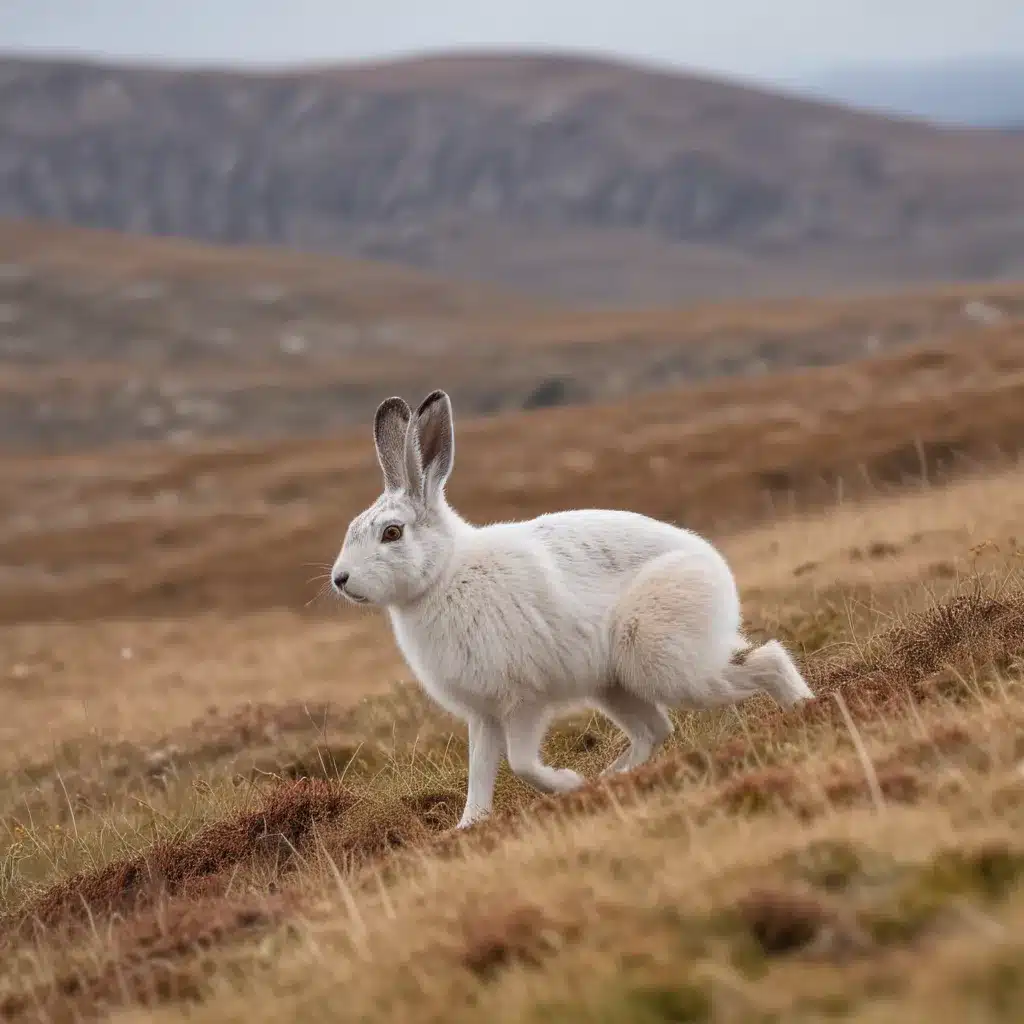
The Dance of the Highland Hares
I trudge through the deep, soft snow, my legs aching with the effort. The smooth, white blanket stretches out before me, unmarked save for the delicate tracks of the creatures that call this landscape home. As I round a bend, a flurry of movement catches my eye – a scattering of fluffy, white forms bounding across the hillside. The mountain hares have arrived, and I’m about to join their mesmerizing dance.
These elusive creatures have captivated me for years. Their ability to seamlessly blend into the winter wonderland, their uncanny intelligence, and their boundless energy make them a true marvel of the Highlands. I’ve spent countless hours stalking them, observing their behaviors, and trying to capture their essence through my lens. And now, as I wade through the pristine snow, I feel a surge of excitement at the prospect of another encounter.
As I’ve learned from my previous adventures, the key to getting close to these hares is to approach them directly, making sure they can see me at all times. They’re wary of silent stalkers, but they seem to trust those who make their presence known. So, I start talking to them, letting them know I mean no harm.
Sure enough, the hares pause, their ears pricked, their dark eyes fixed on me. Some remain cautious, bounding away at the first sign of my advance. But others, perhaps more curious or less skittish, hold their ground, allowing me to inch closer. I can’t help but marvel at their adaptations – the way their wide, furry paws distribute their weight across the snow, the seamless transitions between their winter and summer coats, the lightning-fast reflexes that allow them to evade predators.
The Hares’ Secrets
As I sit beneath a towering Scots pine, sipping my tea and soaking in the sun’s warmth, I can’t help but ponder the mysteries of these remarkable creatures. Their behaviors and population cycles still puzzle researchers, with some regions seeing surges while others experience declines. And the cultural significance of the hare, with its long history of superstition and folklore, adds an intriguing layer to their story.
I think back to the “Names of the Hare,” the Middle English poem that captures the multifaceted nature of these animals. They are “the jumper, the rascal, the racer” – a dizzying array of personalities and characteristics that defy simple categorization. And as I watch the hare on the ridge across the burn, its left eye trained on me, I’m struck by the sense that there’s an entire world within this creature that I can only begin to understand.
As writer Anna Fleming has eloquently described, the hare seems to be an ancient, mythical symbol that we humans have long tried to interpret and comprehend. Perhaps that’s why they continue to captivate us, why their very existence sparks such a range of emotions and perspectives.
Composing the Hare’s Melody
It’s with these thoughts in mind that I meet up with composer Bill Carslake, who is embarking on a new project to capture the essence of the mountain hare through music. As we hike into the hills, our conversation turns to the challenge of representing these elusive creatures on the stage.
“How would you represent a mountain hare on the stage?” Bill asks, his eyes alight with curiosity.
I pause, considering the question, and a metaphor suddenly comes to mind. “A disco ball,” I reply. “Hares catch the eye in a dazzle of (almost ridiculous) movement. Their myriad nature – running, hiding, watching, relaxing, frisking, quaking, yawning, bathing – are flashes of a thousand glittering faces. And beneath this reflective exterior, something is always hidden.”
Bill nods, his brow furrowed in thought. “A disco ball,” he muses. “Yes, I can see it. The hare’s kaleidoscopic energy, the flashes of light and shadow, the sense of mystery. That’s a fascinating starting point.”
As we continue our trek, I can’t help but wonder what kind of enchanting melodies and rhythms Bill will weave to capture the essence of these captivating creatures. For in the end, the mountain hare is not just a physical being, but a symbol, a mirror that reflects the very depths of the human experience. And to compose its song is to unlock the secrets of the hills, to dance with these furry denizens of the Highlands.
Returning to the Loch Ness Shores
As I make my way back down the mountain, my mind still swimming with the wonders of the hares, I can’t help but feel a sense of connection to the land around me. This is the kind of place that fosters a deep appreciation for the natural world, where the boundaries between human and animal, reality and myth, seem to blur and dissolve.
It’s no wonder that Loch Ness Shores, the campsite I’m visiting, has become a hub for those seeking to immerse themselves in the splendor of the Scottish Highlands. Here, amidst the towering mountains, the serene lochs, and the rich tapestry of wildlife, one can truly find the space to explore, to wonder, and to discover the magic that lies within.
As I return to the comfort of the campsite, I know that the memory of the mountain hares will linger with me, a spark that will continue to ignite my imagination and draw me back to these enchanted hills. For in the end, it is these fleeting, enigmatic encounters that make the Highlands such a captivating and transformative place – a realm where the mundane and the extraordinary coexist, where the boundaries between the known and the unknown are constantly shifting, and where the human spirit can soar.

